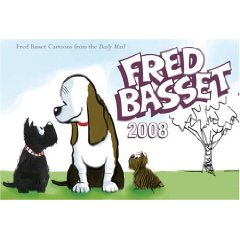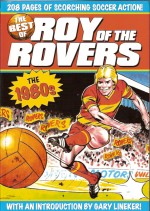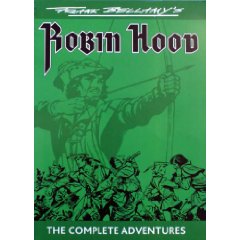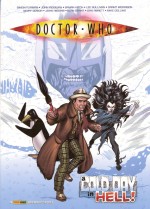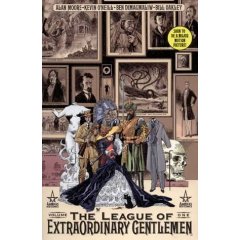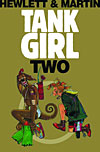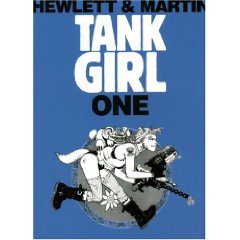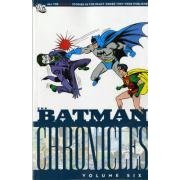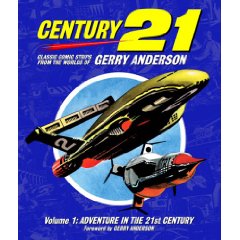
By various (Reynolds and Hearn)
ISBN: 978-1-905287-93-2
After years of subtle manoeuvring and outright begging, some of the greatest strips in British comics history are finally available in glossy high-quality colour compilations selected by dedicated devotee Chris Bentley and with the blessing of Gerry Anderson (who provides a fascinating and informative introduction) himself.
TV Century 21 (the unwieldy “Century” was eventually dropped) was modeled after a newspaper – albeit from 100 years into the future – and this shared conceit carried the avid readers into a multimedia wonderland as television and reading matter fed off each other. The incredible comics adventures were supplemented with stills taken from the TV shows (and later, films) and photos also graced the text features and fillers which added to the unity of one of the industry’s first “Shared Universe” products,
Number #1 launched on January 23rd 1965, instantly capturing the hearts and minds of millions of children in the 1960s, and further proving to British comics editors the unfailingly profitable relationship between television shows and healthy sales.
Filled with high quality art and features, printed in gleaming photogravure, TV21 featured such strips as Fireball XL5, Supercar and Stingray. In a bizarre attempt to be topical the allegorically Soviet state of Bereznik constantly plotted against the World Government (for which read “The West”) in a futuristic Cold War to augment the aliens, aquatic civilizations and common crooks and disasters that threatened the general well-being of the populace. Even the BBC’s TV “tomorrows” were represented by a full-colour strip starring The Daleks.
Although Thunderbirds did not premiere on TV until September (with Frank Bellamy’s incredible strip joining the line-up in January 1966) Lady Penelope and Parker had an earlier debut to set the scene, and eventually the aristocratic super-spy won her own top-class photogravure magazine in January 1996. And as Anderson’s newest creations launched into super-marionated life, their comics exploits filtered into TV21 and even their own titles.
A complete and chronological archive would be unfeasible so this book has gathered a variety of complete adventures from the various serials, beginning with the Fireball XL5 epic ‘The Astran Assassination’, by Alan Fennell, Mike Noble, Eric Eden and Ron Embleton which originally appeared in issues #15-26 (May-July 2065) wherein an alien envoy attempting to forestall an intergalactic border war was murdered on Earth and Steve Zodiac of the World Space Patrol, aided by Lady Penelope and Troy Tempest (ooh! Crossover!) must find the killer before Earth is sucked into disaster!
Next up is a classic Thundebirds romp from Scott Goodall and Frank Bellamy. ‘Chain’ Reaction’ ran in TV21 and TV Tornado #227-234, May -July 2069) wherein the Tracy boys had to stop an out of control 50,000 ton space freighter from impacting in the middle of San Francisco – and that’s just the start of an epic calamity that threatened to destroy the entire Pacific Rim!
Anderson’s stalwart submarine heroes from the Good Ship Stingray were pitted against a bizarre and malevolent spectre in the eerie mystery ‘The Haunting of Station 17’ by Fennell and Embleton (from issues #23-30, June-August 2065) whilst Captain Scarlet is represented here by the beautiful if unconventional ‘The Football King’ by Howard Elson and Mike Noble from TV21 and TV Tornado #194-195 (October 2068). This full colour cover story reverted to monochrome grey-tones for its interior pages, but the real oddity was the genre blending as the indestructible Spectrum agent had to protect a soccer-mad Bedouin potentate by joining his personal football team.
Lady Penelope foiled a Bereznik plot to destroy Unity City from a secret Australian base in ‘The Luveniam Affair’ (by Fennel and Frank Langford from issues #36-42 of her own magazine, September-November 1966) whilst her pals from International Rescue had to conquer ‘The Devil’s Crag’ to rescue a lost schoolboy (Fennell and Bellamy, TV21 #184-187, July-August 2068); a spectacular visual extravaganza that belies its deceptively simple plot.
Developed from the 1966 film Thunderbirds Are Go! the crew of Space Exploration vehicle Zero X had an auspicious and entertaining run of their own adventures in TV21, as this superb yarn by Angus P Allan and Mike Noble demonstrates. ‘Planet of Bones’ (TV21 and TV Tornado #218-224, March-May 2069) found the team in rip-roaring action on a world of deadly skeletal dinosaurs!
‘Superjunk’ from TV Century 21 #72-81(June-August 2066) pitted the Stingray team against futuristic Chinese pirates in a cracking tale by Dennis Hopper and Ron’s brother Gerry Embleton, whilst unsung genius Brian Lewis illustrated ‘Starburst’; a classy black and white thriller by Alan Fennell (from Thunderbirds Extra, March 1966) that found the heroes ranging from the bottom of the Pacific Ocean to the icy depths of interplanetary space to save a pair of dying astronauts.
This first incredible volume concludes with ‘Leviathan’, a glorious Captain Scarlet saga by writers Allan and Goodall with black-and-white and colour art from Mike Noble, Don Harley and Frank Bellamy (from TV21 #185-189, August 2068) which sees Cloudbase crashing into the sea, Mysteron agent Captain Black captured and the World Navy’s greatest super-ship threatened by resurrected Nazi U-Boats!
Crisp, imaginative writing, great characters and some of the very best science-fiction art of all time make this a must-have book for just about anybody with a sense of adventure and love of comics. It doesn’t get better than this.
Artwork © A.P. Films (Merchandising) Ltd/Century 21 Publishing Ltd 1965-1969. Published under license from Anderson Entertainment Ltd 2009. All Rights Reserved.

